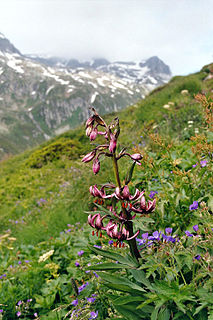
The lily family, Liliaceae, consists of about 254 genera and about 4075 known species of flowering plants within the order Liliales. They are monocotyledonous, perennial, herbaceous, often bulbous geophytes. Plants in this family have evolved with a fair amount of morphological diversity despite genetic similarity. Common characteristics include large flowers with parts arranged in threes: with six colored or patterned petaloid tepals arranged in two whorls, six stamens and a superior ovary. The leaves are linear in shape, with their veins usually arranged parallel to the edges, single and arranged alternating on the stem, or in a rosette at the base. Most species are grown from bulbs, although some have rhizomes. First described in 1789, the lily family became a paraphyletic "catch-all" (wastebasket) group of petaloid monocots that did not fit into other families and included a great number of genera now included in other families and in some cases in other orders. Consequently, many sources and descriptions labelled "Liliaceae" deal with the broader sense of the family.
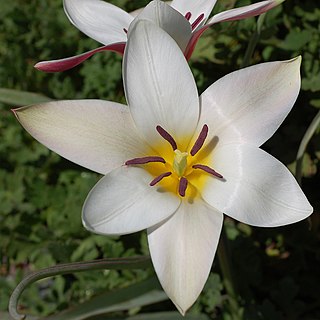
Tulipa clusiana, the lady tulip, is an Asian species of tulip native to Afghanistan, Iran, Iraq, Pakistan and the western Himalayas. It is widely cultivated as an ornamental and is reportedly naturalized in France, Spain, Portugal, Italy, Tunisia, Greece, and Turkey.

Tulipa gesneriana, the Didier's tulip or garden tulip, is a species of plant in the lily family, cultivated as an ornamental in many countries because of its large, showy flowers. It is the national flower of Afghanistan. This tall, late-blooming species has a single blooming flower and linear or broadly lanceolate leaves. This is a complex hybridized neo-species, and can also be called Tulipa × gesneriana. Most of the cultivars of tulip are derived from Tulipa gesneriana. It has become naturalised in parts of central and southern Europe and scattered locations in North America.

Amana edulis is a flowering bulb that is native to China, Japan, and Korea.

Tulips (Tulipa) form a genus of spring-blooming perennial herbaceous bulbiferous geophytes. The flowers are usually large, showy and brightly colored, generally red, pink, yellow, or white. They often have a different colored blotch at the base of the tepals, internally. Because of a degree of variability within the populations, and a long history of cultivation, classification has been complex and controversial. The tulip is a member of the lily family, Liliaceae, along with 14 other genera, where it is most closely related to Amana, Erythronium and Gagea in the tribe Lilieae. There are about 75 species, and these are divided among four subgenera. The name "tulip" is thought to be derived from a Persian word for turban, which it may have been thought to resemble. Tulips originally were found in a band stretching from Southern Europe to Central Asia, but since the seventeenth century have become widely naturalised and cultivated. In their natural state they are adapted to steppes and mountainous areas with temperate climates. Flowering in the spring, they become dormant in the summer once the flowers and leaves die back, emerging above ground as a shoot from the underground bulb in early spring.

Tulipa tarda, the late tulip or tarda tulip, is a species of flowering plant in the family Liliaceae. It is a perennial growing from a bulb. By some sources the accepted name is Tulipa urumiensis. It has a leathery tunic that is glabrous on the inside. It has up to seven linear green leaves that can be up to 20 cm long. The stem is between 4 and 20 cm long. The yellow flowers have white tips, anthers and stamen are yellow.

Tulipa albanica is a flowering plant in the tulip genus, family Liliaceae that is native to Albania. It was discovered near the village of Surroj in Albania in 2010. The plant is a critically endangered (CR) as it grows in an area smaller than 100 ha, surrounded by mining activities.

Tulipa armena, the Armenian tulip, is an Asian species of tulip native to the historical Armenian Highlands as the name implies; current regions of Armenia, modern day Turkey, Iran, and South Caucasus.

Amana is a small genus of flowering bulbs in the lily family, closely related to tulips and included in Tulipa by some authors. Amana is found in China, Japan and Korea. As of June 2012 the World Checklist of Selected Plant Families recognizes four species, three of which were formerly placed in the genus Tulipa:

Tulipa saxatilis is a Greek and Turkish species of plants in the genus Tulipa in the family Liliaceae.
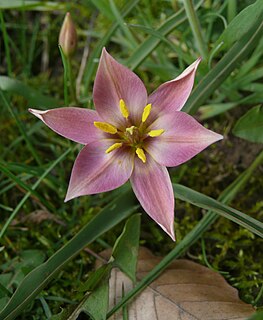
Tulipa humilis is a species of flowering plant in the lily family, found in Syria, Lebanon, Israel, Turkey, Iran, and the North Caucasus region of Russia. The flowers are pink with yellow centers. Its preferred habitat are rocky mountain slopes. It is known by several other names in horticulture.
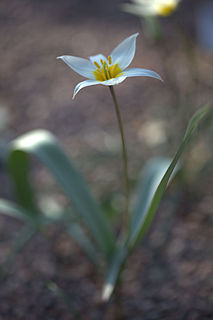
The polychrome tulip is of flowering plant in the tulip genus Tulipa, family Liliaceae. It is sometimes classified as a subspecies of Tulipa biflora and was also considered a synonym for T. buhseana Boiss.

Tulipa sprengeri, or Sprenger's tulip, is a wild tulip from the Pontic coast of Turkey. It is quite rare and possibly extinct in the wild, but widely cultivated as an ornamental.
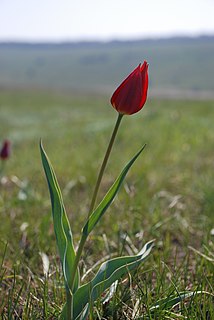
Tulipa schrenkii or Tulipa suaveolens, Schrenck's tulip, is a bulbous herbaceous perennial of species of tulip (Tulipa) in the family of the Liliaceae. It belongs to the section tulipa.

Tulipa linifolia the flax-leaved tulip or Bokhara tulip is a species of flowering plant in the tulip genus Tulipa, family Liliaceae, native to Tajikistan, Uzbekistan, northern Iran and Afghanistan. Growing to 20 cm (8 in) tall, it is a bulbous perennial with wavy red-margined sword-shaped leaves, and bowl-shaped red flowers in early to mid-spring. Each petal has blackish marks at the base.
Tulipa aleppensis is a wild tulip found in Southeastern Turkey, Syria, near Beirut in Lebanon and Israel.

Tulipa agenensis is a Middle Eastern species of flowering plants in the family Liliaceae. It is native to Turkey, Iran, Cyprus, the Aegean Islands, Syria, Lebanon, Israel, Jordan, and Palestine, and naturalized in the central and western Mediterranean.

Tulipa sylvestris, the wild tulip or woodland tulip, is a Eurasian and North African species of wild tulip, a plant in the lily family. Its native range extends from Portugal and Morocco to western China, covering most of the Mediterranean and Black Sea Basins, and Central Asia. The species is also cultivated as an ornamental and naturalized in central and northern Europe as well as a few scattered locations in North America. It is a bulb-forming perennial, usually with yellow flowers, sometimes tinged red on the outside. In the Pakistani region of Balochistan it is the provincial flower.

The taxonomy of Tulipa places the genus in the family Liliaceae, and subdivides it as four subgenera, and comprises about 75 species.

Tulipa orphanidea is a species of the genus Tulipa, in the family Liliaceae, described by Pierre Edmond Boissier and Theodor Heinrich Hermann von Heldreich (1862).















